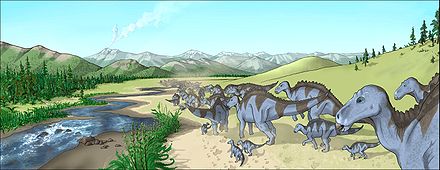Maiasaura
| Maiasaura | ||||||||||||
|---|---|---|---|---|---|---|---|---|---|---|---|---|

Skeletal reconstruction of Maiasaura with young |
||||||||||||
| Temporal occurrence | ||||||||||||
| Upper Cretaceous (Middle to Upper Campanium ) | ||||||||||||
| 80.6 to 72 million years | ||||||||||||
| Locations | ||||||||||||
|
||||||||||||
| Systematics | ||||||||||||
|
||||||||||||
| Scientific name | ||||||||||||
| Maiasaura | ||||||||||||
| Horner & Makela, 1979 | ||||||||||||
| Art | ||||||||||||
|
||||||||||||
Maiasaura ("Good Mother Lizard") is a genus of duck-billed dinosaurs from the Upper Cretaceous in North America . The herbivores lived like probably all Hadrosauriden in herds and brooded in colonies. Maiasaura wasscientifically described by the well-known paleontologist Jack Horner using fossils from the rocks of the Two Medicine Formation in the US state of Montana , where all the remains known to date come from.
anatomy
The body structure of Maiasaura evidently showed no special elements, one found no ridge or armor. One feature was the duck's bill, which featured up to 2,000 teeth. Maiasaura probably reached a weight of two to three tons and was about seven meters long.
Brood care

Maiasaura brooded in colonies as known from many species of birds living today. The researchers found several nests , some of them still in good condition, in a very small space . Since the remains of freshly hatched or very young animals were found in some nests, the leg bones of which were not yet fully developed, and the floor of the nests was littered with eggshell fragments, researchers suspect that Maiasaura were nestling and that the eggshells had trampled on. The young Maiasaura probably stayed in the nest until they were old enough to go looking for food.
The remains of well-chewed, presumably gagged plant food that was found in the nests also support this theory. The type of Maiasaura nest, which was about one meter deep, two meters wide and round, is used as evidence for the theory of Maiasaura's nestling. Most of the eggs were in an upright position. They were about eight inches long, tapered to a point and the narrower end stuck in the ground. The edge of the nest was probably made of mud or silt, the interior of the nest was lined with soft vegetation.
The fact that the young of the Maiasaura could have been nestlings requires extremely active brood care of the parent animals. So they had to protect the nest from enemies, first giving the eggs and later the young the necessary warmth to ensure their survival, and constantly supplying the young with food. Hence the generic name, which means "good mother lizard".
This type of brood care, comparable to that of today's animals, appears surprising with dinosaurs, but the chances of survival of the young in a breeding colony are much higher than if they had to look after themselves from the start as those who had fled the nest .
The hadrosaurs have also been shown to be able to emit sounds and thus probably give a warning call when danger threatened. It is believed that the dams always returned to the same place for breeding and rearing. The young grew up very quickly, after only two years they had reached a length of about three meters. Then growth slowed down and by about eight years old they were fully grown.
Individual evidence
- ^ Gregory S. Paul : The Princeton Field Guide To Dinosaurs. Princeton University Press, Princeton NJ et al. 2010, pp. 302-303, ISBN 978-0-691-13720-9 , online .
- ↑ http://www.dinosaurier-interesse.de/web/Dinosaurier-Dateien/brutpflege2.html